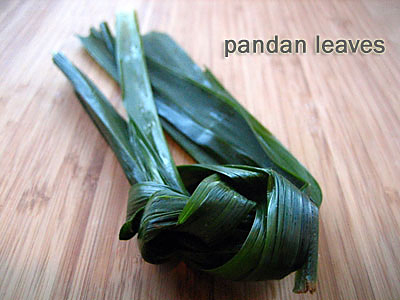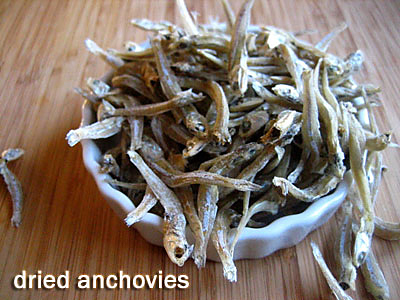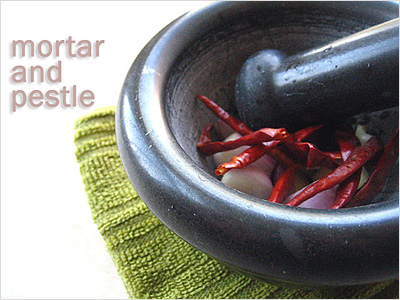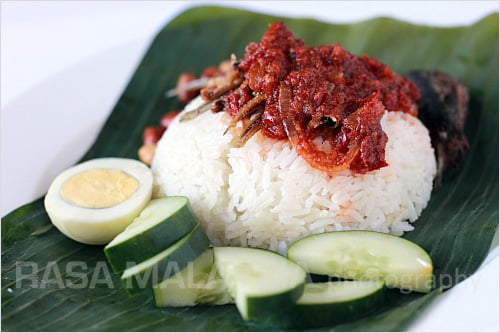Nasi Lemak Recipe (Malaysian Coconut Milk Rice with Anchovies Sambal) pictures (1 of 3)
As a self-proclaimed Malaysian home cook, it’s a shame that it took me so long to prepare nasi lemak,the de facto national dish of Malaysia. In my opinion, a truly remarkable nasi lemak is not to be taken lightly; it should fulfill a few requisites: quality, texture, flavors, and, of course, the right ingredients. This past weekend, I finally found the time and dedication to make this legendary dish…
The difference between a good nasi lemak and an exceptionally marvelous nasi lemak lies in the use ofpandan leaves/screwpine leaves. Possessing highly fragrant floral smell, these leaves are used abundantly in Malaysian cuisine to infuse rice dishes or desserts with the signature aroma; a nasi lemak will not be a true nasi lemak without their presence. The other main ingredient of nasi lemak is dried anchovies, or known locally by ikan bilis. These little salted fish are used in the sambal.
As sambal is of the essence when making nasi lemak, I was extremely zealous when preparing it. I shun away from electrical appliances. Nasi lemak deserves better, it deserves to be prepared the traditional way, that is, with mortar and pestle.
I gathered all the ingredients for my rempah (spice paste), patiently and gracefully pounded away just like any traditional Malaysian home cooks do. This very exercise brought back a flood of memories. As a child, I loved observing my grandmother, my mother, and my aunt when they prepared their rempah withbatu giling (a flat surfaced granite grinding stone); I would always volunteer to help them with the chore as it was pure fun playing real life masak-masak (cooking). As I reminisced back those childhood days in my family’s kitchen, I came to realize that it was probably the beginning of my life-long passion for cooking. So, here I present you nasi lemak, a truly Rasa Malaysia dish.
RECIPE: NASI LEMAK
INGREDIENTS:
Coconut Milk Steamed Rice
2 cups of rice
3 screwpine leaves (tie them into a knot as shown above)
Salt to taste
1 small can of coconut milk (5.6 oz size)
Some water
TAMARIND JUICE
1 cup of water
Tamarind pulp (size of a small ping pong ball)
SAMBAL IKAN BILIS (DRIED ANCHOVIES SAMBAL)
1/2 red onion
1 cup ikan bilis (dried anchovies)
1 clove garlic
4 shallots
10 dried chillies
1 teaspoon of belacan (prawn paste)
1/4 teaspoon of salt
1 tablespoon of sugar
OTHER INGREDIENTS
2 hard boiled eggs (cut into half)
3 small fish (sardines or smelt fish)
1 small cucumber (cut into slices and then quartered)
METHOD:
- Just like making steamed rice, rinse your rice and drain. Add the coconut milk, a pinch of salt, and some water. Add the pandan leaves into the rice and cook your rice.
- Rinse the dried anchovies and drain the water. Fry the anchovies until they turn light brown and put aside.
- Pound the prawn paste together with shallots, garlic, and deseeded dried chilies with a mortar and pestle. You can also grind them with a food processor.
- Slice the red onion into rings.
- Soak the tamarind pulp in water for 15 minutes. Squeeze the tamarind constantly to extract the flavor into the water. Drain the pulp and save the tamarind juice.
- Heat some oil in a pan and fry the spice paste until fragrant.
- Add in the onion rings.
- Add in the ikan bilis and stir well.
- Add tamarind juice, salt, and sugar.
- Simmer on low heat until the gravy thickens. Set aside.
- Clean the small fish, cut them into half and season with salt. Deep fry.
- Cut the cucumber into slices and then quartered into four small pieces.
- Dish up the steamed coconut milk rice and pour some sambal ikan bilis on top of the rice.
- Serve with fried fish, cucumber slices, and hard-boiled eggs.





